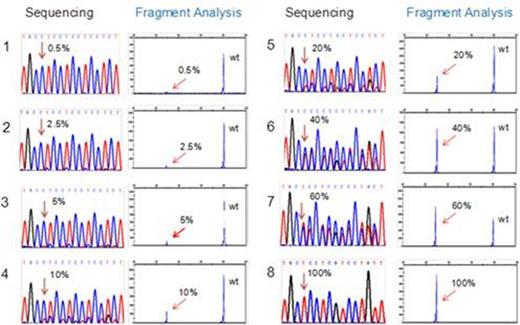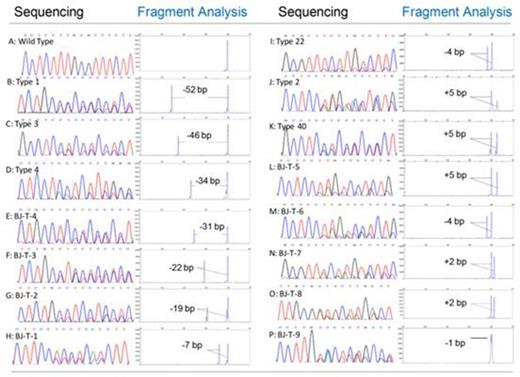Abstract
Background: CALR mutations were recently identified in a substantial proportion of persons with essential thrombocythemia (ET) and with primary myelofibrosis (PMF) without JAK2V617F. Consequently rapid, sensitive and specific methods to detect and quantify these mutations are needed.
Methods: We studied samples from 1088 persons with myeloproliferative neoplasms (MPNs) including 421 JAK2V617F negative subjects with ET, PMF, polycythemia vera (PV), chronic myeloid leukemia (CML) and hyper-eosinophilic syndrome (HES). Detection of CALR exon 9 mutations was done by PCR amplification followed by fragment length analysis and direct sequencing. Dilution assays were used to determine CALR mutant allele burden.
Results: We detected CALR mutations in blood and bone marrow samples from 152 subjects with ET and with PMF but not in samples from normal or persons with PV, CML or HES. CALR mutant peaks were distinct from wild-type peaks and dilution experiments indicated a sensitivity level of 0.5-5% for a CALR mutant allele in a wild-type background. Diverse types of mutations were detected including deletions, insertions and complex indels. All mutations were confirmed by direct sequencing. We also used dilution experiments to quantify mutant allele burden. We were able to reproducibly detect mutant allele levels as low 5% (0.5-5%) in a wild-type background.
Conclusions: PCR amplification followed by fragment length analysis is a rapid, sensitive and specific method for screening persons with MPNs for CALR mutations, especially those with ET and PV with JAK2V617F and for estimating mutant allele burden.
Titration analyses of sensitivity of CALR mutation screening by sequencing and fragment analyses.
Titration analyses of sensitivity of CALR mutation screening by sequencing and fragment analyses.
Figure 3 Sequencing traces show heterozygous mutation of CALR. Gene scan electropherogram from PCR method and partial sequence of CALR exon 9 from sequencing method (numbering according to GenBank access number: NC_000019.9). A-P: Detected a wild type and 15 CALR mutation types by sequencing and fragment analysis methods. A: wild type, B-I: deletions, H-L: insertions, M-P: complex indels.
Figure 3 Sequencing traces show heterozygous mutation of CALR. Gene scan electropherogram from PCR method and partial sequence of CALR exon 9 from sequencing method (numbering according to GenBank access number: NC_000019.9). A-P: Detected a wild type and 15 CALR mutation types by sequencing and fragment analysis methods. A: wild type, B-I: deletions, H-L: insertions, M-P: complex indels.
No relevant conflicts of interest to declare.
Author notes
Asterisk with author names denotes non-ASH members.




This feature is available to Subscribers Only
Sign In or Create an Account Close Modal